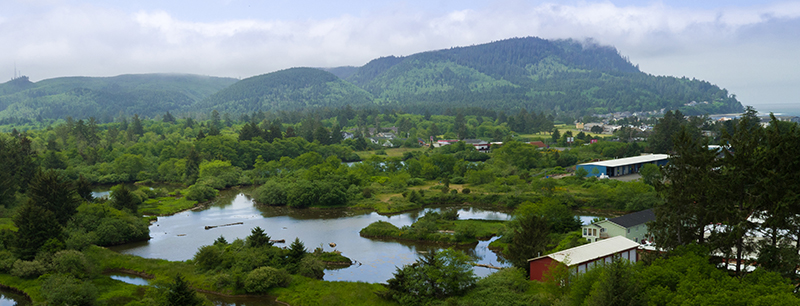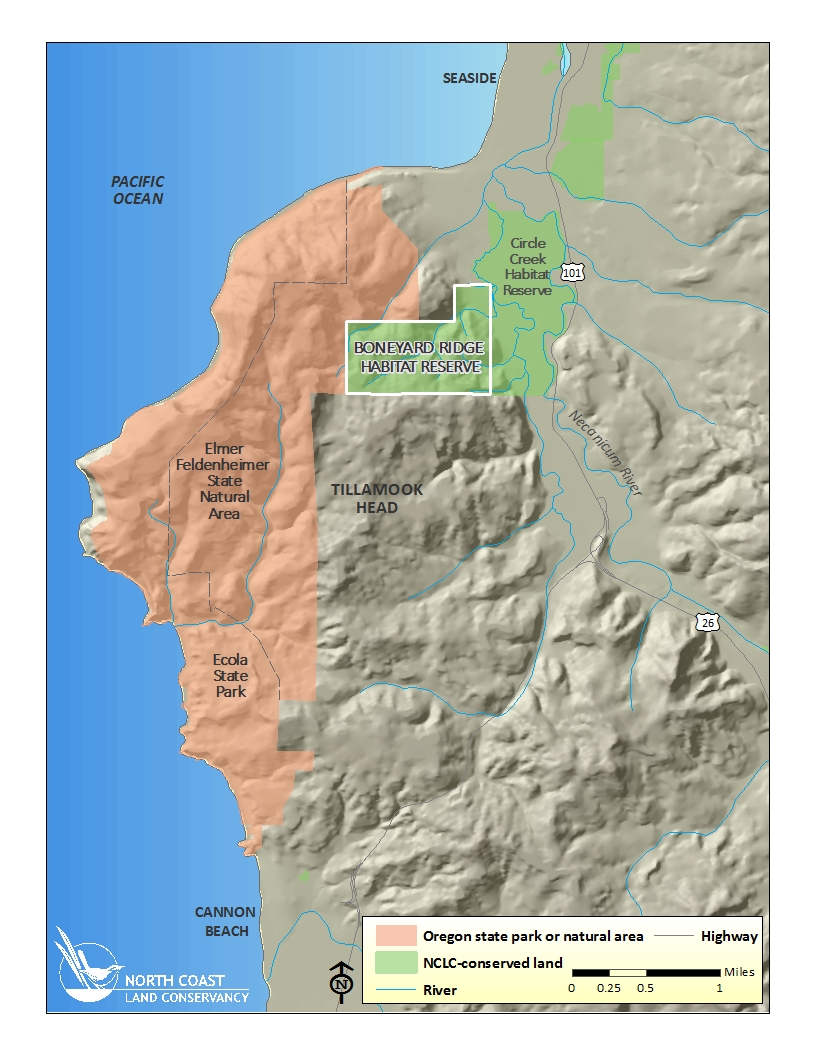North Coast Land Conservancy finalized its acquisition of 340-acre Boneyard Ridge on Tillamook Head today (July 27). Permanent conservation of what had been a commercial tree farm now creates an unbroken, 3500-acre corridor of conserved land stretching from the ocean shore to the Necanicum River floodplain between the communities of Seaside and Cannon Beach.
The significance of this single property acquisition is hard to overstate, according to NCLC Executive Director Katie Voelke. “It’s just one puzzle piece, but it includes an entire watershed,” she said. “Because of all our previous work in the Necanicum estuary, this one puzzle piece brings together an entire coastal ecosystem: near-shore ocean, headlands, forested watershed, floodplain, and estuary.”

Boneyard Ridge occupies the left half of the headland in this photograph. In the foreground are additional lands conserved by North Coast Land Conservancy in Seaside: Seaside Mill Ponds (now owned by the City of Seaside), Shangrila Habitat Reserve, and (at the base of the headland) Circle Creek Habitat Reserve. (Photo: Morrisey Video Production)
North Coast Land Conservancy has been working since 2011 to conserve Boneyard Ridge in partnership with Lewis and Clark Timberlands. The $1.3 million purchase was funded with a $524,000 grant from the Oregon Watershed Enhancement Board, $500,000 from an anonymous donor, and contributions from more than 120 additional donors.
Boneyard Ridge is adjacent to Elmer Feldenheimer State Natural Area and Ecola State Park, considered globally significant for its biodiversity. East of Boneyard Ridge lies the private, nonprofit land conservancy’s own 360-acre Circle Creek Habitat Reserve, site of a landmark floodplain restoration project and home to a variety of native wildlife. The land conservancy is in the process of developing recreational trails at Circle Creek and expects to expand that trail network into Boneyard Ridge in the future.
Habitat corridors such as the one created by conservation of Boneyard Ridge help connect and reestablish wildlife populations separated by human activities such as, in this case, logging. Such corridors encourage biodiversity and help moderate the impact of habitat fragmentation caused by human development elsewhere on the landscape.
Forests managed for wood products such as lumber and fiber have different characteristics than those managed for habitat, Voelke explained. “Allowing the forest in this corridor to grow into a mature temperate rainforest will make it possible for plants and animals native to this habitat to flourish.”

From a high point on Boneyard Ridge, the staff of North Coast Land Conservancy looks north to Seaside and east to NCLC’s Circle Creek Habitat Reserve.
Conservation of Tillamook Head began in the 1930s, when founding Oregon State Parks superintendent Sam Boardman made the first acquisitions of ocean-fronting land that would become the foundation of Ecola State Park. Addition of what is now Elmer Feldenheimer State Natural Area beginning in the 1970s doubled the area of state-conserved land on the headland. The adjacent Boneyard Ridge property has been commercially logged for decades and currently ranges from recovering young stands to trees some 50 years old. NCLC’s challenge going forward is to utilize the latest findings in restoration science to put the property on a healthy trajectory toward maturing into a high-functioning rainforest.
Given that the forest on Boneyard Ridge has been repeatedly harvested, the relative youth of the tree stands is actually beneficial, according to Craig Leech, Oregon Parks and Recreation Department forester/arborist. Because older stands of trees in neighboring Elmer Feldenheimer State Natural Area were not thinned at the proper time, Leech said, the forest there has stagnated and faces a “tentative future.”
“NCLC now has an opportunity to learn from OPRD’s mistakes and put these young stands on a pathway toward coastal older forest structure, which is in short supply in Oregon,” Leech said.
The Boneyard Ridge acquisition is a “milestone in land conservation” on Oregon’s north coast, said OPRD Commissioner Robin Risley of Cannon Beach. “Kudos to North Coast Land Conservancy for its true vision, tenacity and collaboration with others to bring this project to fruition. This marriage of landscapes creates a legacy for future Oregonians.”
The Boneyard Ridge property has four streams, including 2 miles of salmon-bearing streams, which currently support not only spawning coho salmon but cutthroat trout and western brook lamprey. It serves as a home or migration stopover to at least 90 species of birds, including pileated woodpeckers, olive-sided flycatchers, bald eagles, and rufous hummingbirds. Amphibians on the property include red-legged frogs and Columbia torrent salamanders, and mammals here range from black bears to elk. Even more native wildlife species are known to inhabit Ecola State Park and may already have spread into Boneyard Ridge. NCLC’s acquisition of Boneyard Ridge addresses three conservation priorities identified by the Oregon Department of Fish and Wildlife’s Oregon Conservation Strategy: Tillamook Head, the Necanicum River estuary, and the temperate rainforest coast-wide.

Comments